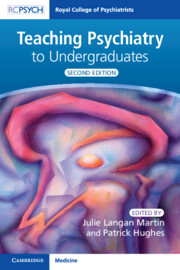Book contents
- Teaching Psychiatry to Undergraduates
- Teaching Psychiatry to Undergraduates
- Copyright page
- Contents
- Contributors
- Section 1 Principles of Medical Education
- Section 2 The Undergraduate Psychiatry Curriculum: Planning and Delivery
- Section 3 Clinical Placements in Psychiatry
- Section 4 Formal Teaching
- Section 5 Materials Development
- Chapter 5.1 Online Learning
- Chapter 5.2 The Flipped Classroom
- Chapter 5.3 Use of Technology and Social Media
- Section 6 Gathering feedback and quality improvement
- Section 7 Student Welfare
- Section 8 Developing as a medical educator
- Index
- References
Chapter 5.2 - The Flipped Classroom
from Section 5 - Materials Development
Published online by Cambridge University Press: 12 October 2022
- Teaching Psychiatry to Undergraduates
- Teaching Psychiatry to Undergraduates
- Copyright page
- Contents
- Contributors
- Section 1 Principles of Medical Education
- Section 2 The Undergraduate Psychiatry Curriculum: Planning and Delivery
- Section 3 Clinical Placements in Psychiatry
- Section 4 Formal Teaching
- Section 5 Materials Development
- Chapter 5.1 Online Learning
- Chapter 5.2 The Flipped Classroom
- Chapter 5.3 Use of Technology and Social Media
- Section 6 Gathering feedback and quality improvement
- Section 7 Student Welfare
- Section 8 Developing as a medical educator
- Index
- References
Summary
The flipped classroom approach is considered as an effective method of active learning due to its potential to enhance learning through higher order thinking. However in order to successfully embed the flipped approach, educators need to mindful of the change in roles and input required, including the time and effort needed to develop motivation (incentive), learning materials (exposure), activities, assessments (assess) and impactful support mechanisms (Brame, 2013). In this chapter we explore, what the flipped classroom is, how the flipped classroom approach can be successfully embedded and highlight essential actions for implementation of the flipped approach.
- Type
- Chapter
- Information
- Teaching Psychiatry to Undergraduates , pp. 130 - 137Publisher: Cambridge University PressPrint publication year: 2022

